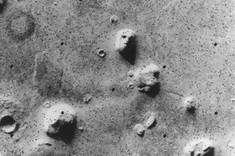
A shadow and tracks of NASA’s Mars rover Opportunity appear in this March 22, 2016, image, which has been rotated 13.5 degrees to adjust for the tilt of the rover. The hillside descends to the left into “Marathon Valley.” The floor of Endeavour Crater is seen beneath the underside of a solar panel.
Credit: NASA/JPL-Caltech
NASA’s Opportunity Mars rover isn’t settling gently into its dotage.
On March 10, Opportunity — which has been exploring the Red Planet since January 2004 — drove on a 32-degree slope, the steepest ever tackled on Mars.
The goal of this mountaineering expedition was to get Opportunity close enough to study a rock target near the crest of a Red Planet landform dubbed Knudsen Ridge, which is part of a larger feature called Marathon Valley (because it’s where Opportunity’s odometer passed 26.2 miles, or 42.2 kilometers — the distance of a marathon here on Earth).
But Opportunity didn’t quite reach the rock, even though the rover’s handlers commanded a healthy number of wheel rotations to compensate for anticipated slippage on the slope.
“The wheels did turn enough to have carried the rover about 66 feet (20 meters) if there had been no slippage, but slippage was so great, the vehicle progressed only about 3.5 inches (9 centimeters),” NASA officials wrote in a statement Thursday (March 31).
“This was the third attempt to reach the target and came up a few inches short,” they added. “The rover team reached a tough decision to skip that target and move on.”

Dust streaks on the rear solar panel of NASA’s Mars rover Opportunity on March 21, 2016 after a series of drives where the rover was pointed steeply uphill.
Credit: NASA/JPL-Caltech
So Opportunity backed down the hill and then, in a series of drives over the past three weeks, motored about 200 feet (60 m) southwestward, toward a different Marathon Valley rock target.
Observations made by NASA’s Mars Reconnaissance Orbiter suggest that both the original target and the new one harbor clay minerals, which form in the presence of liquid water, NASA officials said.
Opportunity landed on the Red Planet in January 2004, a few weeks after its twin, Spirit, touched down. Both rovers were tasked with three-month missions to search for evidence that liquid water once flowed on Mars.

0 of 10 questions complete
Spirit and Opportunity found plenty of such signs, and then kept chugging right along. Spirit was pronounced dead in 2011, and Opportunity is still going strong, adding to its off-world distance-driving record. (Opportunity’s odometer currently reads 26.53 miles, or 42.69 km.)
Opportunity also held the previous steep-slope record, which the rover set in late 2004, when it was nearing a feature called Burns Cliff. Opportunity’s tilt reached about 30 degrees back then, rover team members wrote in descriptions of images the rover captured at the time.
Follow Mike Wall on Twitter @michaeldwall and Google+ . Follow us @Spacedotcom , Facebook or Google+ . Originally published on Space.com .

Comments are closed.